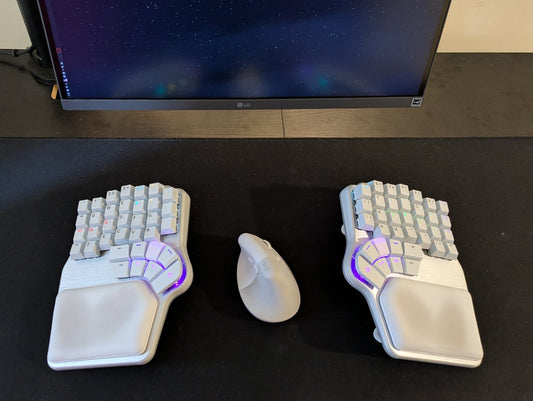The price and what comes with it:
They are expensive; there's no way to sugarcoat it. You can get some cheaper models for around $150, but if you want one with all the good stuff - like hot-swappable switches, nice design, good software, and funky keycaps - you'll be looking at a $300 budget, minimum, which can go above $600 if you start adding more and more features.We might want to know more about that expensive and mythic object when discussing these amounts. So now, besides having to pay a huge amount of money, we must research. Otherwise, how are you going to justify spending that much money? Here are some of the things you'll have to get familiar with before pulling the trigger:
-
Mechanical switches: These models tend to mount mechanical switches, and it's not nice to get a keyboard with an unpleasant feeling, so you have to know more about the topic. Most models are hot-swappable, meaning you can always correct the problem with the switches, but it's another issue to deal with, and we're just starting.
- Hand sizes and how they can impact the choice: Some models are better for smaller hands, while others have keys further away and work better for bigger hands; you'll have to find information from users reporting their experiences or get a 1:1 scale reproduction of the layout and see if it works for you.
- Know the keyboard's features: Do I need hand rests? Is tenting something I can get used to? What the heck is negative tilt? Since these keyboards have unique features you might be unfamiliar with, understanding the elements and seeing if they are what you need is essential to make the right choice.
We've learned typing by force, and it's deeply engraved in our muscle memory. Retraining that reptilian part of our brain where instincts are coded takes more time and frustration than we'd like. But we can promise it will pay off, eventually.
Bad typing techniques receive a draconic punishment; if you press the Y with the left hand or the T with the right, there's a high chance you abandon the keyboard temporarily, especially if the learning period coincides with days when you have to do a lot of work.
Yes, ergonomic keyboards do not only force you to learn about features but also to learn to touch type. They are real tyrants!
How do ergonomic keyboards make up for the missing keys? Via software.
Yes, you'll have to learn how to deal with extra software to customize the keyboard and make the most of it. You'll have to get familiar with concepts like layers, macros, superkeys, combos, and almost anything you can imagine. Experts in computers won't find a problem with customization software, but for newcomers, they might be a problem. In other words, you must learn to use software to utilize your $300 keyboard. Some models come with tenting or lifting kits. Those intend to keep your hands in a healthier position and relieve pressure from the wrists, but the drawback is that you must adapt to another position as if learning about features, touch typing, and software wasn't enough.Besides, some of them will force to adjust the
These models have peculiar shapes and can be strange; if you ignore the instructions and how to use them properly, you might end up replacing one pain for another even worse. If not used properly, they will only move the pain or the injury from one place to another. So, this tyrannic and expensive piece of tech also tells you how to seat and place the chair and the arms. It's attacking your freedom systematically. You can't fight all the battles to win the war. Just surrender and adapt to the height and position. Who knows, this might be good for your posture...
They ruin the ability to enjoy normal keyboards:
Ultimately, the worst crime of these ergonomic keyboards is how they will hinder your ability to enjoy any other keyboard model.
Because if you go through the retraining process, learn how to make the most of a bunch of thumb keys, and use the customization tools successfully, well, you have already corrected your posture, technique, and; what will happen is that you'll feel discomfort whenever you start typing on a regular model.
Your hands will feel trapped in a subpar piece of plastic that hurts your hands and lacks keys on the thumbs. Your super special keys with shortcuts and macros won't be there to help you; instead, you'll find dull commands like the caps lock. But more important than anything, the backspace and the enter will be on the further edges of the keyboard, forcing your hand back to its old habits.
Unfortunately, there's no solution to this problem. As our Dygmate Nazmul put it: "Yeah, you will forget how to use a regular keyboard, and then just have to get a bunch of Raises. Once you find a better way, the old way is going to be distasteful. And it should be distasteful"









